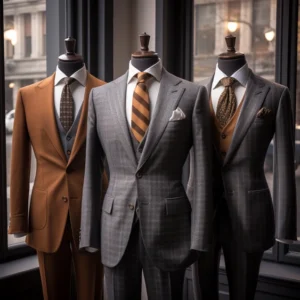In the dynamic world of business, the way one presents oneself plays a crucial role in establishing credibility, confidence, and professionalism. Mastering the art of sartorial sophistication goes beyond merely following dress codes; it involves understanding the nuances of business attire, selecting appropriate ensembles, and leveraging style to make a lasting impression in the corporate arena. This comprehensive guide explores the elements of a business wardrobe, tips for sartorial success, and the impact of a well-crafted professional image.
1. The Anatomy of a Business Wardrobe
Key Components:
- Suits: Investing in well-tailored suits in classic colors like navy, charcoal, and gray.
- Shirts: Building a collection of quality dress shirts in neutral tones, including white and light blue.
- Ties: Curating a selection of versatile ties that complement various suit and shirt combinations.
- Footwear: Choosing classic leather shoes, such as Oxfords or Derbies, in black or brown.
2. Understanding Dress Codes
Different business settings and events often have specific dress codes, and understanding these codes is essential for making appropriate wardrobe choices.
Common Dress Codes:
- Business Formal: Strict professional attire, typically required for board meetings or formal events.
- Business Professional: A polished and tailored look suitable for everyday office wear.
- Business Casual: A more relaxed yet still professional style, allowing for some flexibility in attire.
3. Building a Versatile Wardrobe
Versatility is key when creating a business wardrobe. A few well-chosen pieces can be mixed and matched to create a variety of professional looks.
Capsule Wardrobe Essentials:
- Neutral Suits: Versatile suits that can be dressed up or down depending on the occasion.
- Classic Shirts: Timeless shirts that form the foundation of a professional wardrobe.
- Adaptable Accessories: Ties, pocket squares, and cufflinks that add a touch of personality.
4. Tailoring and Fit
The importance of a well-tailored wardrobe cannot be overstated. Proper fit enhances comfort, confidence, and the overall aesthetic.
Tailoring Tips:
- Jacket and Trousers: Ensuring jackets and trousers fit well at the shoulders, chest, and waist.
- Shirt Fit: Opting for shirts with a comfortable fit around the neck and shoulders.
- Hem and Sleeve Length: Confirming that trousers and shirt sleeves are the appropriate lengths.
5. Embracing Timeless Style
While fashion trends come and go, timeless style endures. Incorporating classic elements ensures a sophisticated and enduring professional image.
Timeless Style Elements:
- Minimalist Accessories: Choosing accessories that are subtle and complement the overall look.
- Simple Patterns: Incorporating subtle patterns in shirts and ties for a touch of sophistication.
- Quality Fabrics: Opting for high-quality fabrics that not only look good but also withstand the test of time.
6. Expressing Individuality
While adhering to professional dress codes is essential, there’s room for subtle expressions of personal style.
Personal Touches:
- Accessory Choices: Adding a personal touch through unique ties, cufflinks, or pocket squares.
- Tailored Details: Customizing elements like shirt collars or suit linings for a distinctive look.
- Grooming and Presentation: Maintaining a polished appearance through well-groomed hair and attention to personal hygiene.
7. Dressing for Success: The Psychological Impact
Beyond aesthetics, the way one dresses can significantly impact confidence, perception, and professional success.
Psychological Impact:
- Confidence Boost: Wearing well-fitted and stylish attire contributes to a heightened sense of confidence.
- Professional Image: A polished appearance reinforces a positive professional image.
- Perceived Competence: Dressing professionally can positively influence how colleagues and superiors perceive one’s competence.
8. Navigating Contemporary Trends
While classic styles form the foundation of a business wardrobe, staying informed about contemporary trends can add a modern touch.
Contemporary Elements:
- Modern Suit Silhouettes: Exploring slimmer or more relaxed suit silhouettes based on personal preference.
- Updated Accessories: Incorporating modern tie or pocket square styles for a fresh look.
- Color Choices: Experimenting with subtle deviations from traditional color palettes.
Conclusion: Elevating Your Professional Persona
Mastering sartorial sophistication in the business realm is a journey that involves a keen understanding of dress codes, a curated wardrobe, and an appreciation for timeless style. By investing in quality pieces, embracing individuality within professional constraints, and recognizing the psychological impact of one’s attire, individuals can elevate their professional persona and make a lasting impression in the corporate world. Ultimately, the art of dressing for success extends beyond clothing—it is a strategic tool for creating a powerful and confident professional identity.

